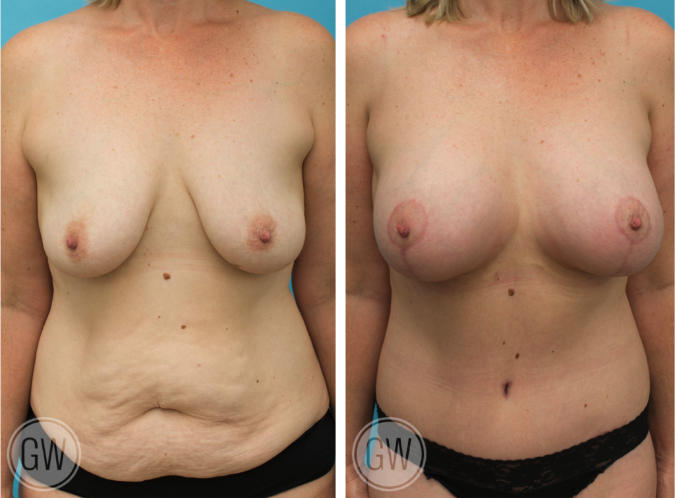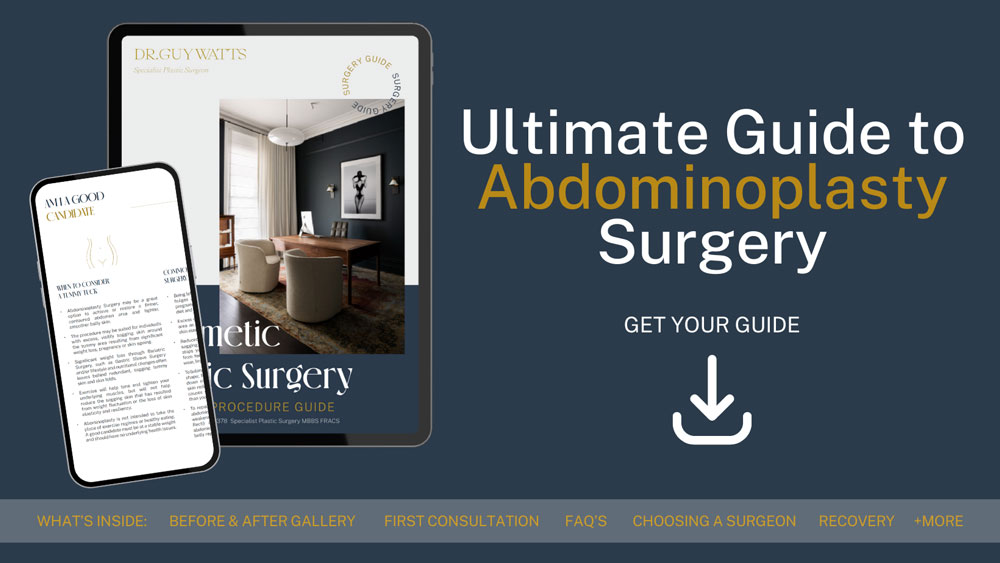
04 Aug Surgical Options for a C Section Pouch
For many individuals who have undergone a Caesarean section, the physical changes in the abdominal region may extend well beyond the initial recovery. A common concern, particularly among Perth-based patients, is the development of a persistent bulge or overhang in the lower abdomen, often referred to as a “C section pouch”. This feature may not improve with exercise, physiotherapy, or time, and for some, it can cause both physical and functional concerns.
This condition may arise due to a combination of stretched skin, residual fat, muscle separation (known as rectus diastasis), and scarring along the surgical incision. In circumstances where lifestyle interventions do not lead to meaningful change, surgery may be an appropriate option to address these structural issues.
Dr Guy Watts, a Specialist Plastic & Reconstructive Surgeon based in Perth, Western Australia, provides comprehensive assessment and evidence-based surgical planning for individuals considering treatment. This article offers detailed insights into the causes of a C section pouch, how it may be managed surgically, and what patients in Perth can expect throughout their journey.
Take our quiz, and find out if you are ready for surgery
What Is a C Section Pouch?
Understanding Post-Caesarean Changes
A C section pouch typically refers to a protruding area of skin and tissue that forms above the incision site following a Caesarean section. This is a common occurrence and can vary in presentation depending on individual healing and body structure.
This pouch may include:
- Redundant skin and subcutaneous fat: During pregnancy, the abdominal skin and soft tissues stretch significantly. After delivery, this tissue may not return to its pre-pregnancy position, especially if skin elasticity is reduced. Residual fatty tissue can also accumulate in the lower abdomen, contributing to the pouch-like appearance.
- Muscle laxity or rectus diastasis: The abdominal muscles often stretch and separate during pregnancy to accommodate the growing uterus. This condition, known as rectus diastasis, may persist post-delivery. The separation creates a gap that can lead to core weakness and a bulging abdomen, particularly in the area above the C section scar.
- Scar tethering and tissue adhesion: The scar from the Caesarean incision may adhere to the underlying tissues during the healing process. This can pull the skin downwards, creating a shelf-like effect where the surrounding tissue appears more prominent.
These factors often overlap, creating a complex structural presentation that may require surgical intervention to restore anatomical balance.
Why It Persists Postpartum
While some postpartum changes improve over time, the persistence of a C section pouch can be influenced by multiple factors, including:
- Genetic predisposition: Some individuals naturally have lower skin elasticity or tend to store fat in specific areas. These factors can affect how the body recovers after pregnancy and surgery.
- Multiple pregnancies: With each pregnancy, the abdominal wall and skin are stretched again. This repeated stretching can reduce the skin’s ability to retract, and it may exacerbate existing rectus muscle separation or scarring.
- Healing variability and scar response: Everyone heals differently. For some, scar tissue may form in a way that causes tightness, asymmetry, or a noticeable bulge. In others, the body may deposit more fat in the lower abdomen as part of its natural physiology.
- Abdominal wall trauma: In some cases, the trauma of childbirth and surgery can weaken the muscle and connective tissue structure of the abdomen. Over time, this may contribute to core instability or visible abdominal protrusion.
Persistent pouches often indicate structural issues that cannot be resolved through lifestyle measures alone.
When Might Surgery Be Considered?
Common Concerns Raised by Perth Patients
Many individuals who consult Dr Guy Watts in Perth describe similar experiences. Some of the most frequently expressed concerns include:
- Persistent abdominal bulging despite weight loss and exercise: Even after achieving a healthy body weight and engaging in abdominal workouts, the pouch often remains. This can be frustrating for patients who are otherwise fit and active.
- Difficulty wearing fitted clothing or swimwear: The lower abdominal prominence may create challenges in finding clothing that fits comfortably or aesthetically. Patients often report feeling self-conscious when wearing snug outfits or activewear.
- Ongoing core weakness or instability: Some individuals experience reduced abdominal strength due to rectus diastasis. This may affect posture, physical performance, and the ability to perform daily activities such as lifting or bending.
- Skin irritation and hygiene issues: Skin folds created by the pouch can trap moisture and become irritated. Some patients report chronic rashes, redness, or discomfort in the lower abdomen.
- Limited physical comfort during activity: Whether during exercise or routine tasks, the presence of a protruding pouch can affect mobility and comfort. This may lead to reduced physical activity, which can further impact overall wellbeing.
These symptoms may indicate the need for surgical assessment, particularly when the issue is impacting quality of life.
When Non-Surgical Approaches Aren’t Enough
Initial management typically includes non-surgical strategies, such as:
- Targeted physiotherapy: Especially in the early postpartum period, physiotherapy can help activate deep abdominal muscles and improve core stability. While valuable, physiotherapy cannot close significant muscle separation or remove excess skin.
- Abdominal binding and support garments: These can offer temporary support and may help with posture or appearance under clothing. However, they do not correct the underlying anatomy.
- Exercise and nutrition programs: Many individuals undertake fitness programs to reduce abdominal fullness. While these promote general health, they cannot reverse skin laxity or correct rectus diastasis once established.
If these measures do not improve the pouch, surgery may be the only option to address the structural components effectively.
DOWNLOAD DR WATTS’ GUIDE TO ABDOMINOPLASTY

Surgical Treatment Options with Dr Guy Watts
✓ Abdominoplasty (Abdominal Surgery)
Abdominoplasty is a surgical procedure designed to:
- Remove excess lower abdominal skin and fat that persists after pregnancy or weight changes.
- Improve abdominal contour by redraping tissues and restoring a smoother transition between the lower and upper abdomen.
- Address scar tethering by releasing adhesions and repositioning the scar for a flatter appearance.
In patients with a C section pouch, abdominoplasty often includes careful dissection around the previous scar and repositioning of the navel. The scar is typically placed low on the abdomen to be easily concealed.
✓ Rectus Diastasis Repair
This is commonly performed in conjunction with abdominoplasty. The goals of this procedure are to:
- Close the gap between separated abdominal muscles using durable internal sutures.
- Reinforce the abdominal wall, thereby restoring strength and improving posture.
- Reduce the central abdominal bulge caused by the muscle separation.
Repairing rectus diastasis may also assist with functional concerns such as back pain, breathing difficulty during exertion, or pelvic instability. Patients combining muscle repair with liposuction can refer to our article on Recovery After 360 Liposuction for more insight into post-surgery healing.
✓ Scar Revision
Scar revision focuses on:
- Excising the old Caesarean scar if it is raised, wide, or tethered to underlying tissues.
- Reclosing the area using layered sutures to promote better healing and appearance.
- Reducing discomfort or asymmetry caused by scar distortion.
Scar revision may be a standalone procedure or part of a comprehensive abdominal contouring plan.
What to Expect During Consultation and Recovery
✓ Personalised Assessment in Perth
During a consultation with Dr Guy Watts in Perth:
- A full medical history is reviewed to understand past surgeries, pregnancies, and any current health concerns.
- A physical examination assesses skin quality, abdominal muscle tone, and scar characteristics.
- Dr Watts discusses individual goals, including functional symptoms and desired outcomes, to create a tailored surgical plan.
- The discussion includes potential risks, limitations, and the expected recovery process, ensuring patients can make an informed decision.
Every surgical plan is developed in accordance with the patient’s anatomy, needs, and expectations.
✓ Surgical Planning and Recovery Overview
The procedure is performed in a licensed Perth hospital under general anaesthetic. Recovery typically involves:
- An overnight hospital stay, though some patients may return home the same day depending on procedure complexity and support at home.
- Initial rest period of 10 – 14 days, during which patients should avoid lifting and bending.
- Wearing a compression garment to minimise swelling and support the healing tissues.
- Follow-up reviews at 1 week, 6 weeks, and several months to monitor healing and adjust activity levels.
Patients gradually resume physical activity, usually starting with gentle walking and progressing under guidance. Swelling typically subsides within a few weeks, but full results may take up to 6 months.
Choosing a Qualified Plastic & Reconstructive Surgeon in Perth
✓ The Importance of Specialist Training
It’s important to choose a fully qualified Specialist Plastic & Reconstructive Surgeon, as they:
- Have completed advanced surgical training recognised by the Royal Australasian College of Surgeons (RACS).
- Are registered with the Australian Health Practitioner Regulation Agency (AHPRA).
- Have expertise in both functional and reconstructive surgery, enabling them to manage complex cases like rectus diastasis or scar complications.
Dr Guy Watts has extensive training in both reconstructive and aesthetic procedures, and focuses on delivering care that prioritises patient safety and anatomical restoration.
✓ Patient-Focused Surgical Care in Perth
At his Perth-based clinic, Dr Watts:
- Provides individualised assessments, acknowledging that every patient’s anatomy and goals are unique.
- Operates exclusively in fully accredited hospital environments, adhering to national surgical safety standards.
- Encourages open, transparent discussions about expected results, risks, and realistic outcomes without pressure or guarantees.
Patients are supported from initial consultation through to long-term follow-up.
FAQs about Surgery for a C Section Pouch
Learn More with Dr Guy Watts in Perth
If you’re experiencing a persistent C section pouch and would like to explore surgical treatment options, Dr Guy Watts in Perth can assist. As a Specialist Plastic & Reconstructive Surgeon, he provides a detailed, evidence-informed assessment tailored to your anatomy, goals, and long-term wellbeing.
For more information or to book a consultation, contact us.
Further Reading
- Read more in Dr Guy Watts’ Abdominoplasty category
- Read Dr Guy Watts’ blog about Tummy Tuck – Abdominoplasty
- Read Dr Guy Watts’ blog about Recovery After a Bodylift
About Dr. Guy Watts – MED0001539378
FRACS (Plas) – Specialist Plastic Surgeon In Perth WA
Dr. Guy Watts is a Specialist Plastic Surgeon (AHPRA MED0001539378) with an extensive career that spans across renowned plastic surgery clinics worldwide. His experience has been honed through invaluable experiences at esteemed establishments such as the New York Eye and Ear Infirmary and the renowned Pitanguy Clinic in Brazil.
Having collaborated with the foremost cosmetic plastic surgeons on a global scale, Dr. Watts has chosen to return to Perth after a 17-year journey of intensive training and invaluable professional experience to bring the latest practices and technology in cosmetic plastic surgery to his patients.
Dr. Watts is a Fellow of the Royal Australasian College of Surgeons (FRACS) and a Member of the Australian Society of Plastic Surgeons (ASPS), Australasian Society of Aesthetic Plastic Surgeons (ASAPS) and the International Society of Aesthetic Plastic Surgeons (ISAPS).
Read about the potential Risks and Complications of Surgery
Read the Patient Information and Resources
About CLINISPA
Clinispa is Dr Watts’ bespoke medical clinic performing Cosmetic Aesthetic treatments. At Clinispa, we offer advanced clinical treatments in a luxurious and calming environment, tailored to support your skin’s health and appearance.
Clinispa aesthetic services are performed by Dr Guy Watts’ nursing professionals, who have a passion for and solid understanding of facial aesthetics.
All Clinispa clients are considered individually, with a personalised treatment plan consisting of advanced scientific approaches to cosmetic aesthetics. We incorporate innovative technologies in conjunction with superiorly formulated skin care.
For more information about the full range of Clinispa Aesthetic of Cosmetic Treatments visit the Clinispa website








Sorry, the comment form is closed at this time.